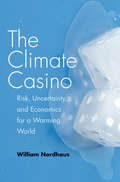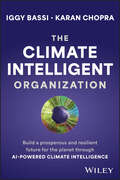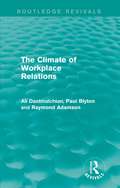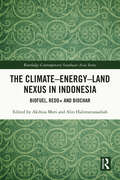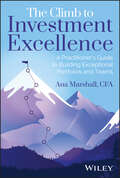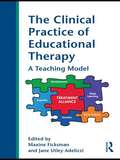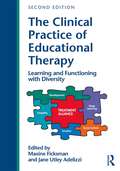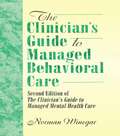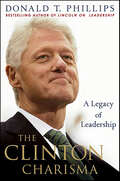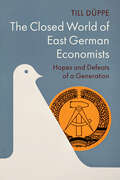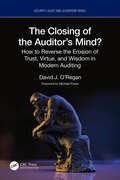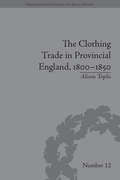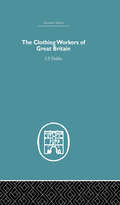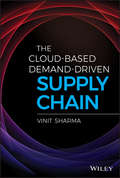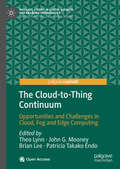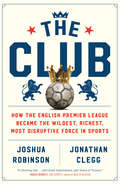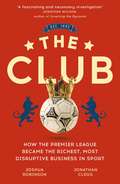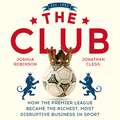- Table View
- List View
The Climate Casino
by William D. NordhausClimate change is profoundly altering our world in ways that pose major risks to human societies and natural systems. We have entered the Climate Casino and are rolling the global-warming dice, warns economist William Nordhaus. But there is still time to turn around and walk back out of the casino, and in this essential book the author explains how. Bringing together all the important issues surrounding the climate debate, Nordhaus describes the science, economics, and politics involved--and the steps necessary to reduce the perils of global warming. Using language accessible to any concerned citizen and taking care to present different points of view fairly, he discusses the problem from start to finish: from the beginning, where warming originates in our personal energy use, to the end, where societies employ regulations or taxes or subsidies to slow the emissions of gases responsible for climate change. Nordhaus offers a new analysis of why earlier policies, such as the Kyoto Protocol, failed to slow carbon dioxide emissions, how new approaches can succeed, and which policy tools will most effectively reduce emissions. In short, he clarifies a defining problem of our times and lays out the next critical steps for slowing the trajectory of global warming.
The Climate Corporation
by Forest Reinhardt David E. Bell Mary ShelmanClimate Corporation is a San Francisco-based data analytics company focused on agricultural applications. It was acquired by Monsanto in 2013. In 2015, Climate's decision support platform was used on 75 million acres of farmland in the U.S.; however, most of those acres were "free" acres. To build a viable business, Climate had to convince farmers to subscribe to and pay for premium offerings. The case describes Climate's technology approach, product offerings, marketing plans, and the competitive environment for "digital agriculture".
The Climate Intelligent Organization: Build a Prosperous and Resilient Future for the Planet Through AI-Powered Climate Intelligence
by Iggy Bassi Karan ChopraLearn to make sound business decisions on a rapidly changing planet In The Climate Intelligent Organization, renowned entrepreneurs and climate intelligence pioneers Iggy Bassi and Karan Chopra, deliver an intuitive and practical guide to the transformative power of AI-driven Unified Climate Intelligence (UCI). Written with the business practitioner in mind, the book showcases how holistic climate analysis can be integrated into decisions, growth plans, and investments as organizations navigate the challenges and opportunities of climate change. You'll discover: How UCI can redefine competitive advantage and reshape leadership. Strategies to improve climate-related financial performance. A roadmap for driving resilient value creation in the new climate economy. Perfect for managers, executives, directors, policy makers, entrepreneurs, founders, and other business leaders, The Climate Intelligent Organization will also prove invaluable to finance and sustainability professionals seeking new insights into how to adapt to a changing planet.
The Climate Solution: India's Climate-Change Crisis and What We Can Do about It
by Mridula RameshFrom fatal heatwaves and cruel droughts to devastating floods and fast-depleting water tables, climate change is the greatest disruptor of our time ? and it can no longer be ignored. For most of us the odds seem overwhelming and solutions seem out of reach. Yet, in this forcefully argued book, climate change practitioner, teacher and investor Mridula Ramesh emphasizes that while the situation is grim, it is not without hope. Drawing on her extensive practical and investing experience, she explores myriad facets of this raging issue: why women are peculiarly affected by a warming climate; how climate change poses a security threat to the Indian state; why just focussing on green sources of power is an incomplete solution for India; how managing waste can create hundreds of thousands of urban jobs and how households can cope in a `Day Zero? water situation. In doing so, she shows how climate warriors, from the cotton fields of Punjab and thriving eco start-ups in Bengaluru, to a forest guardian in Assam and the johads of Rajasthan, have employed ingenuity and initiative to adapt to the changing conditions ? and sometimes reverse their shattering effects. Timely, urgent and thought-provoking, this book is an urgent call to action ? and an essential manifesto for every Indian citizen to follow.
The Climate of Workplace Relations (Routledge Revivals)
by Paul Blyton Ali Dastmalchian Ray AdamsonFirst published in 1991, this book investigates not only the processes of industrial relations themselves but also the climate in which they work. As well as studying union behaviour, it views the topic from the wider perspective of human resource management and integrates theories of industrial relations and organizational analysis. The extensive empirical evidence presented, which draws on manufacturing and service industries in Canada, is used to examine such areas as cooperation between union and management, employee perceptions and corporate culture. This interesting reissue will be of importance to all those studying the dynamics of organizations and industrial relations processes, and ways in which a productive climate can be established and maintained.
The Climate–Energy–Land Nexus in Indonesia: Biofuel, REDD+ and biochar (Routledge Contemporary Southeast Asia Series)
by Akihisa Mori Alin HalimatussadiahThis book extends the framework of the climate-energy-land nexus to elucidate political, economic, social, and institutional factors and causal mechanisms that stringent climate targets bring about, rather than mitigate a disproportional heavy burden on the forest sector in Indonesia. Assessing climate, energy, agricultural, forest, and transmigration policies, and REDD+ and biochar solutions through a multidisciplinary approach, ranging from biological, agricultural, technological, economic, and institutional lenses, the book identifies the political-economic and socio-technical regimes that cause the crosssectoral transfer of responsibility for greenhouse gas emissions to palm-oil-based biofuel, imposing an excess burden on the forest sector and accelerating indirect land-use change. It also proposes possible countermeasures for agricultural and forest sectors, reconfirming that technical applications and integrated policymaking should trigger the socioeconomic changes that will make transformative change happen in Indonesia. As an analysis of the success, or otherwise, of stringent climate targets, policies, and technological and non-technological measures on the reduction of greenhouse gases, this book will be of great interest to students and scholars in the fields of environment & sustainability, Asian studies, energy, environment and agriculture, forestry, and agriculture & environmental sciences. It will also appeal to practitioners and policymakers tackling net-zero emissions and land and forest governance.
The Climatic Scene
by Michael J. Tooley Gillian M. SheailOriginally published in 1985, this volume of essays was compiled in honour of Gordon Manley, a major and distinctive twentieth-century figure in climatology. The range and scope of the topics covered reflect the eclectic interests of Manley, whose orientation was always towards the importance of climate and its impact on mankind. The state of the art of climatic change is considered at different scales by the contributors: from instrumental records on a local scale from Durham and Manchester to discussions on the regional and continental scale. Methodological problems relating to climatic change are treated. The effects of climate and climatic change on plant distribution, disease vectors and agricultural pests are also considered.
The Climb to Investment Excellence: A Practitioner’s Guide to Building Exceptional Portfolios and Teams
by Ana MarshallA go-to resource for institutional investors and asset allocators seeking practical advice from a proven leader in the field In The Climb to Investment Excellence: A Practitioner’s Guide to Building Exceptional Portfolios and Teams, celebrated institutional investor and asset allocator Ana Marshall draws on her 36 years’ experience in finance and investment to deliver a comprehensive and practical blueprint for a resilient and high-performing institutional portfolio, as well as a reliable roadmap for the management of its stakeholders. You’ll discover ready-to-deploy strategies and advice that’s informed by evidence and tried and tested in the real world, helping you to build and manage your team, construct a portfolio, set your goals, select the right managers, and more. You’ll also find: Explorations of three themes that consistently define the careers of successful investors and asset allocators: strategy and planning, trust, and risk management The critical factors every investor and allocator should consider before making any sort of impactful decision Examinations of the importance of resilience in the face of bad fortune or mistakesA can’t-miss resource for institutional investors and asset allocators, The Climb to Investment Excellence will also benefit board members tasked with overseeing their organizations’ investment objectives and performance in a volatile and ever-changing market.
The Clinical Practice of Educational Therapy: A Teaching Model
by Maxine Ficksman Jane Utley AdelizziThe Clinical Practice of Educational Therapy is the first book to provide a comprehensive review of the interdisciplinary profession and practice of educational therapy as it exists today. It describes the scope and practice of educational therapy from its European roots to its growing presence in the United States, and provides case studies to illustrate the work of educational therapists. Key Features: Interdisciplinary Perspective - Other books focus on either educational or therapeutic interventions but rarely discuss the blend and synergy of disciplines that are the hallmark of the profession. Illustrative Cases - The text draws heavily on case studies as a means of understanding the practice of educational therapy, especially the relationship between therapist and client. Expertise - Chapter authors are either experienced educational therapists or allied professionals who have made scholarly contributions to the profession, such as Dorothy Ungerleider, Patricia Waters, Roslyn Arnold, and George McCloskey. In addition to educational therapy students and practitioners, this book is appropriate for those working in related fields including special education, school psychology, school counseling, and social work in educational settings.
The Clinical Practice of Educational Therapy: Learning and Functioning with Diversity
by Maxine Ficksman Jane Utley AdelizziDespite the wide array of services offered to students with learning disabilities, attention-deficit disorder, and a variety of comorbid conditions, large numbers of students are caught in the struggle of surviving school. Unfortunate school experiences may impact their sense of self and the degree of tenacity with which they pursue further training or challenging opportunities in the workplace. These are the people for whom educational therapy provides relief, enlightenment, and the coveted prize of success. The second edition of The Clinical Practice of Educational Therapy, the first textbook in its field, provides a comprehensive perspective of this interdisciplinary profession and practice, reaching out to a more global audience. The book describes the scope and practice of educational therapy from its European roots to its growing presence in the United States, providing readers with case studies and research that illustrate the work of educational therapists across the lifespan in diverse settings. Interdisciplinary Perspective — Other books focus on either educational or therapeutic interventions but rarely discuss the blend and synergy of disciplines (e.g., special education, neuropsychology, assessment, and social work) that are the hallmark of this unique profession. Illustrative Cases — The text draws heavily on case studies as a means of understanding the practice of educational therapy, especially the dynamic relationship that exists between therapist and client. Numerous charts and tables provide visuals for educational therapists as well as allied professionals, parents, and those with learning challenges. Expertise — The editors are both highly visible educational therapists. Chapter authors are either experienced educational therapists or allied professionals who have made scholarly contributions to the profession, such as Trisha Waters, Roslyn Arnold, and George McCloskey. In addition to benefiting educational therapists and students, this book is appropriate for professionals who work in related fields such as special education, regular education, school and educational psychology, neuropsychology, school counseling, psychology, speech and language pathology, art therapy, occupational therapy, and social work, as well as in medicine and psychiatry. NEW TO THE SECOND EDITION The second edition of The Clinical Practice of Educational Therapy: Learning & Functioning with Diversity has revised and updated the chapters from the first edition, and added three new chapters which further define and broaden this field by exploring diverse perspectives: Chapter 10, "Cultivating Character Development: Educational Therapy’s Impact on Individuals, Families, Schools, Educational Policy, and Society" by Maxine Ficksman Chapter 12, "Women and Girls Who Are Disenfranchised: A Global and Interdisciplinary Approach to Educational Therapy" by Jane Utley Adelizzi Chapter 17, "Examining the Efficacy of Graduate Programs in Educational Therapy at California State University, Northridge (CSUN): Educational Therapy Intern, Graduate and Parent Perspectives" by Marcy Dann, Nancy Burstein, Tamarah Ashton, and Sue Sears. These additional chapters, supported by brain-based research, characterize the shifts and changes experienced in a range of settings. Through the treatment alliance, educational therapists address students’ and clients’ ability to experience a more comprehensive model of learning, dependent upon the psychological, social, emotional, cultural and academic environments. The three new chapters range in focus from formal research and graduate training in the field of educational therapy to students throughout the lifespan whose social and educational experiences require a careful eye to not only the academic task at hand but also to the ways in which they cope and adapt to a range of environments and challenges. Lastly, educational therapy’s empathic foundation in practice is exemplified when we consider the global experience of students who strive to learn in situations and settings that threaten their survival a
The Clinical Research Process in the Pharmaceutical Industry (Drugs And The Pharmaceutical Sciences Ser. #19)
by Gary M. MatorenThis book examines the sequence of events and methodology in the industrial clinical research process; a reference for multidisciplinary personnel. It is the conceptual framework involving the philosophical, economic, political, historical, regulatory, planning, and marketing aspects of the process.
The Clinician's Guide to Managed Behavioral Care: Second Edition of The Clinician's Guide to Managed Mental Health Care
by William Winston Norman WinegarManaged care is a revolution impacting the practice of clinicians throughout America. The Clinician’s Guide to Managed Behavioral Care, called “a survival kit” and “must reading,” helps clinicians develop and market professional services attuned to the needs of managed care systems, manage the utilization process, and reshape an office practice or hospital-based program to become more “managed care friendly.” It is newly referenced and updated for clinicians to continue to advocate for their patients and clients.The Clinician’s Guide to Managed Behavioral Care addresses how clinicians can develop and market professional services attuned to the needs of managed care systems, how to best manage the utilization review process, how to re-shape an office practice or hospital-based program to become more “managed care friendly,” and how to best advocate for patients and clients. Readers will understand the history and evolution of attempts to manage mental health care costs and services as well as the emerging clinical, economic, and social trends that will continue to fuel changes in the mental health field in coming years. Importantly, this guide sensitizes readers to the perspectives about mental health care benefits and the treatment field held by the payor community--insurance carriers, HMO’s, and self-insured employers. It allows readers to consider a payor’s view of how professionals can play a crucial role in providing quality services while helping control spiraling mental health care costs--costs that have escalated much faster than other segments of health care.Who can benefit from this book? Practicing psychologists, social workers, psychiatrists, substance abuse counselors, marriage and family therapists, Employee Assistance Professionals, psychiatric nurses, professional counselors, program managers, hospital administrators, and health care marketing professionals will find The Clinician’s Guide to Managed Behavioral Care and invaluable resource.It is often said that in the future, all in the treatment community will be involved in “managing care” and that the most successful clinicians and practices will be those most adept at working with managed care systems on behalf of their patients and clients. This book helps you understand how!Important topics in The Clinician’s Guide to Managed Behavioral Care: the changing marketplace for mental health/substance abuse treatment services assessing market opportunities in light of managed care influences clinical service needs of managed care systems clinical innovations: examples, case studies, vignettes strategies for managing utilization review marketing strategies for office-based practitioners hospital-managed care partnerships contemporary office management strategies to control costs consumers and managed care directory of America’s HMOs directory of America’s Managed Mental Health Care Companies glossary of key terms
The Clinton Charisma: A Legacy of Leadership
by Donald T. PhillipsIt is often overlooked, but Bill Clinton assumed the presidency in one of the most difficult times in our nation's history. The country was in a deep recession, the end of the Cold War had created new threats to our national security, and our health care system was in shambles. The country has now come full circle. Leadership has been replaced with self-interest, cronyism, and fear. More than ever, Bill Clinton's candor and success in adversity warrant revisiting during this age of a closed-door administration and governmental incompetence. The Clinton Charisma is a fascinating, prescriptive guide that reveals the former president's complex leadership techniques, including his attention to public opinion, his ability to take quick corrective action, and his efficient damage control in the face of political and personal difficulty. From diversity to decisiveness, from consensus to compromise, each chapter explores how Clinton employed important leadership principles and the ways in which they were--or were not--effective.The author asks in the introduction, "Are there lessons to be learned from his time in office--from his damage control strategies, from his ability to implement diversity, or from his decision-making process?"The answer, as Donald T. Phillips's The Clinton Charisma makes compellingly clear, is yes.
The Clorox Company: Leveraging Green for Growth
by Elie Ofek Lauren BarleyThe Clorox Company needs to decide on the marketing strategy going forward for its three sustainable brands, Brita, Burt's Bees and Green Works. These brands had fared differently over the past 3 years and each presents multiple courses of action heading into 2011. Management also needs to assess the role the sustainable brands play in Clorox's overall Corporate Responsibility strategy and the implications they have for the other brands (such as Clorox Bleach, 409, and Hidden Valley). The company has set aggressive financial targets in light of its upcoming centennial in 2013. Students need to evaluate whether sustainability is an enduring trend that Clorox should embrace for future growth or whether focusing on its core brands, which currently represent 90% of sales, is a better approach.
The Closed World of East German Economists: Hopes and Defeats of a Generation (Historical Perspectives on Modern Economics)
by Till DüppeHistory is replete with examples of scientists and social scientists working under the yoke of oppressive regimes. In The Closed World of East German Economists, Till Düppe tells the story of a generation of economists whose entire careers coincided with the forty-one-year existence of the German Democratic Republic (GDR). In a micro-historical fashion, he examines the world of East German economists through the formative episodes in the lives of five different economists from this “hope” generation. Using both the perspective of the actors as expressed in interviews and archival material unknown to the actors, the book follows East German economics from the early days of the acceptance of Marxism-Leninism through to its interaction with Western economics and its eventual dissolution following the collapse of the Berlin Wall. It is fascinating insight into the challenges faced by economists in a unique period of European history.
The Closing of the Auditor’s Mind?: How to Reverse the Erosion of Trust, Virtue, and Wisdom in Modern Auditing (Security, Audit and Leadership Series)
by David J. O'ReganIn The Closing of the Auditor’s Mind?, author David J. O’Regan describes internal auditing as an important "binding agent" of social cohesion, for the accountability of individuals and organizations and also at aggregated levels of social trust. However, O’Regan also reveals that internal auditing faces two severe challenges – an external challenge of adaptation and an internal challenge of fundamental reform.The adaptation challenge arises from ongoing, paradigmatic shifts in accountability and social trust. The command- and- control, vertical hierarchies of traditional bureaucracies are being replaced in importance by networked, flattened patterns of accountability. The most challenging assurance demands of the modern era are increasingly located in three institutional domains – in the inner workings of organizations; in intermediary spaces at organizational boundaries; and in extra-mural locations. Internal auditing continues to cling, barnacle- like, to the inner workings of traditional, bureaucratic structures, and it has little to offer the emerging assurance demands on or beyond institutional boundaries. The reform challenge arises from internal auditing’s prevailing tendency toward a rigid, algorithmic, checklist mindset that suppresses practitioners’ creativity and critical thinking. This trend is increasingly narrowing internal auditing’s intellectual and moral horizons. Under the pressures of these challenges, internal auditing is struggling to fulfil its primary purpose of serving the public interest.O’Regan’s powerful book focuses on: The redistribution of social trust from traditional, hierarchical institutions to diffuse, horizontally distributed networks The perennial validity of the classical virtues as the humane foundation of professional activity The role of creative expertise in promoting professional wisdom The Closing of the Auditor’s Mind? is a philosophical audit of a profession on the threshold of crisis. The book presupposes no prior knowledge of philosophy, nor indeed of auditing. Philosophical technicalities are contained in an Appendix, leaving the main text jargon-free. O’Regan provides original and striking perspectives on the malaise of modern internal auditing, and he proposes radical remedies. This captivating and well-informed book is a must-read for all who are concerned with our collective socio-economic and political well-being.
The Clothing Trade in Provincial England, 1800–1850 (Perspectives in Economic and Social History #12)
by Alison ToplisThis detailed study is the first exploration of rural consumption of clothing in early nineteenth-century Britain. Drawing on evidence from a range of sources including newspapers, trade directories, court records, visual sources and surviving garments, Toplis investigates how the apparel of the mass of the British population was acquired.
The Clothing Workers of Great Britain
by S.P DobbsFirst Published in 2005. Routledge is an imprint of Taylor & Francis, an informa company.
The Cloud-Based Demand-Driven Supply Chain (Wiley and SAS Business Series)
by Vinit SharmaIt’s time to get your head in the cloud! In today’s business environment, more and more people are requesting cloud-based solutions to help solve their business challenges. So how can you not only anticipate your clients’ needs but also keep ahead of the curve to ensure their goals stay on track? With the help of this accessible book, you’ll get a clear sense of cloud computing and understand how to communicate the benefits, drawbacks, and options to your clients so they can make the best choices for their unique needs. Plus, case studies give you the opportunity to relate real-life examples of how the latest technologies are giving organizations worldwide the opportunity to thrive as supply chain solutions in the cloud. Demonstrates how improvements in forecasting, collaboration, and inventory optimization can lead to cost savings Explores why cloud computing is becoming increasingly important Takes a close look at the types of cloud computing Makes sense of demand-driven forecasting using Amazon's cloud Whether you work in management, business, or IT, this is the dog-eared reference you’ll want to keep close by as you continue making sense of the cloud.
The Cloud-to-Thing Continuum: Opportunities and Challenges in Cloud, Fog and Edge Computing (Palgrave Studies in Digital Business & Enabling Technologies)
by Theo Lynn Brian Lee John G. Mooney Patricia Takako EndoThe Internet of Things offers massive societal and economic opportunities while at the same time significant challenges, not least the delivery and management of the technical infrastructure underpinning it, the deluge of data generated from it, ensuring privacy and security, and capturing value from it.This Open Access Pivot explores these challenges, presenting the state of the art and future directions for research but also frameworks for making sense of this complex area. This book provides a variety of perspectives on how technology innovations such as fog, edge and dew computing, 5G networks, and distributed intelligence are making us rethink conventional cloud computing to support the Internet of Things. Much of this book focuses on technical aspects of the Internet of Things, however, clear methodologies for mapping the business value of the Internet of Things are still missing. We provide a value mapping framework for the Internet of Things to address this gap. While there is much hype about theInternet of Things, we have yet to reach the tipping point. As such, this book provides a timely entrée for higher education educators, researchers and students, industry and policy makers on the technologies that promise to reshape how society interacts and operates.
The Club: How the English Premier League Became the Wildest, Richest, Most Disruptive Force in Sports
by Joshua Robinson Jonathan CleggThe Club is the previously untold inside story of how English soccer’s Premier League became the wildest, richest, most popular sports product on the planet. This is a sports and business tale of how money, ambition, and twenty-five years of drama remade an ancient institution into a twenty-first-century entertainment empire. No one knew it when their experiment began, but without any particular genius or acumen, the motley cast of billionaires and hucksters behind the modern Premier League struck gold. Pretty soon, everyone wanted to try their luck, from Russian oligarchs to Emirati sheikhs, American tycoons, and Asian Tiger titans. Some succeeded beyond their wildest dreams. Some lost everything. Today, players are sold for tens of millions, clubs are valued in the billions, and games are beamed out to nearly two hundred countries, all while the league struggles to preserve its English soul. Deeply researched and drawing on one hundred exclusive interviews, including the key decision makers at every major English team, The Club is the definitive and wildly entertaining narrative of how the Premier League took over the world.
The Club: How the Premier League Became the Richest, Most Disruptive Business in Sport
by Joshua Robinson Jonathan CleggAn excellent recap, with wonderful access and forensic detail on the Premier League's rise to global alpha status... All told with an arch sense of humour The GuardianHow did English football - once known for its stale pies, bad book-keeping and hooligans - become a commercial powerhouse and the world's premium popular entertainment?This was a business empire built in only twenty-five years on ambition, experimentation and gambler's luck. Lead by a motley cast of executives, Russian oligarchs, Arab Sheikhs, Asian Titans, American Tycoons, battle-hardened managers, ruthless agents and the Murdoch media - the Premier League has been carved up, rebranded and exported to phenomenal 185 countries. The United Nations only recognizes 193.But the extraordinary profit of bringing England's ageing industrial towns to a compulsive global attention has come at a cost. Today, as players are sold for hundreds of millions and clubs are valued in the billions, local fans are being priced out - and the clubs' local identities are fading. The Premier League has become the classic business fable for our globalised world.Drawing on dozens of exclusive and revelatory interviews from the Boardrooms - including Liverpool's John W. Henry, Tottenham's Daniel Levy, Martin Edwards and David Gill at Manchester United, Arsène Wenger and Stan Kroenke at Arsenal, Manchester City's sporting director Txiki Begiristain, and executives at Chelsea, West Ham, Leicester City and Aston Villa - this is the definitive bustand boom account of how the Premier League product took over the world.
The Club: How the Premier League Became the Richest, Most Disruptive Business in Sport
by Joshua Robinson Jonathan CleggThe never-before-told inside story of how the Premier League became the wildest, richest, most popular entertainment business on the planet.How did English football - once known for its stale pies, bad book-keeping and hooligans - become a commercial powerhouse and the world's premium popular entertainment?This was a business empire built in only twenty-five years on ambition, experimentation and gambler's luck. Lead by a motley cast of executives, Russian oligarchs, Arab Sheikhs, Asian Titans, American Tycoons, battle-hardened managers, ruthless agents and the Murdoch media - the Premier League has been carved up, rebranded and exported to phenomenal 185 countries. The United Nations only recognizes 193.But the extraordinary profit of bringing England's ageing industrial towns to a compulsive global attention has come at a cost. Today, as players are sold for hundreds of millions and clubs are valued in the billions, local fans are being priced out - and the clubs' local identities are fading. The Premier League has become the classic business fable for our globalised world.Drawing on dozens of exclusive and revelatory interviews from the Boardrooms - including Liverpool's John W. Henry, Tottenham's Daniel Levy, Martin Edwards and David Gill at Manchester United, Arsène Wenger and Stan Kroenke at Arsenal, Manchester City's sporting director Txiki Begiristain, and executives at Chelsea, West Ham, Leicester City and Aston Villa - this is the definitive bustand boom account of how the Premier League product took over the world.
